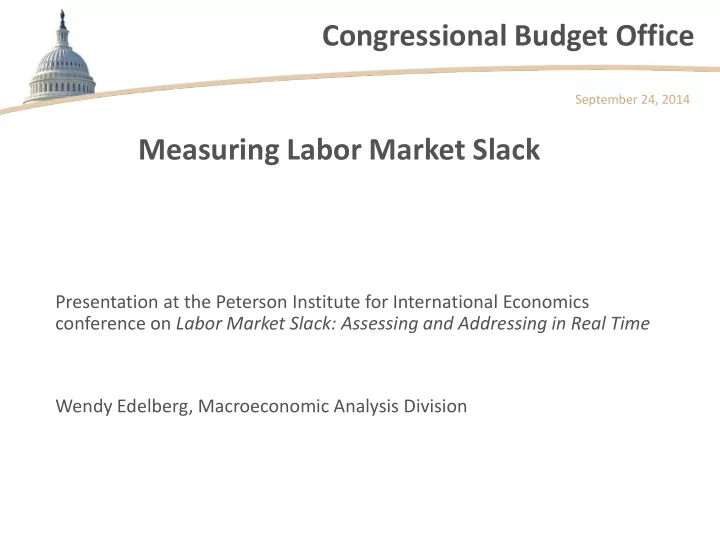

Congressional Budget Office September 24, 2014 Measuring Labor Market Slack Presentation at the Peterson Institute for International Economics conference on Labor Market Slack: Assessing and Addressing in Real Time Wendy Edelberg, Macroeconomic Analysis Division
Estimated Gap Between Actual Output and Potential Output C O N G R E S S I O N A L B U D G E T O F F I C E 1
Slack in the Labor Market In CBO’s view, the current slack in the labor market consists of multiple elements, including: ■ The labor force participation rate is well below what CBO estimates would be achieved if the demand for workers was stronger. ■ The unemployment rate is above CBO’s estimate of the natural rate. ■ The share of part-time workers who would prefer full-time work is significantly higher than before the recession. Continued slow growth in compensation is an important signal that significant slack remains. Measuring slack is quite difficult, and the current amount of slack could be a good deal larger or smaller than CBO estimates. C O N G R E S S I O N A L B U D G E T O F F I C E 2
Rate of Participation in the Labor Force C O N G R E S S I O N A L B U D G E T O F F I C E 3
Actual and Natural Rates of Unemployment C O N G R E S S I O N A L B U D G E T O F F I C E 4
Employment shortfall In the second quarter of 2014, about 3¾ million more people would have been employed, according to CBO’s estimates, if ■ The unemployment rate had returned to its prerecession level, and ■ The labor force participation rate equaled its potential rate. C O N G R E S S I O N A L B U D G E T O F F I C E 5
Workers Who Are Employed Part Time C O N G R E S S I O N A L B U D G E T O F F I C E 6
Measures of the Underutilization of Labor C O N G R E S S I O N A L B U D G E T O F F I C E 7
Measures of Wages and Salaries Paid to Employees C O N G R E S S I O N A L B U D G E T O F F I C E 8
Examples of Difficulties in Measuring Labor Market Slack ■ Potential Labor Force Participation. CBO may have underestimated or overestimated how many people permanently dropped out of the labor force because of such factors as long-term unemployment. ■ Natural Rate of Unemployment. CBO’s estimate depends on the speed of recovery in the efficiency with which employers are filling vacancies. C O N G R E S S I O N A L B U D G E T O F F I C E 9
Notes For more information, see An Update to the Budget and Economic Outlook: 2014 to 2024 (August 2014), www.cbo.gov/publication/45653, as well as The Slow Recovery of the Labor Market (February 2014), www.cbo.gov/publication/45011. Slide 3: The potential labor force participation rate is CBO’s estimate of the participation rate that would be achieved if the demand for workers was currently stronger. That rate reflects the estimated effects both of demographics (such as the age distribution of the population) and of the number of people who have left the labor force permanently in response to the recession and slow recovery. Slide 4: The natural rate is CBO’s estimate of the unemployment rate arising from all sources except fluctuations in aggregate demand. Slide 7: The U-6 measure of the underutilization of labor combines the number of people who are unemployed, the number of people who are marginally attached to the labor force (those who are not currently looking for work but are willing and able to work and have looked for a job in the past 12 months), and the number of people who are working part time for economic reasons. The measure is expressed as a percentage of the labor force plus the number of marginally attached workers. C O N G R E S S I O N A L B U D G E T O F F I C E 10
Recommend
More recommend